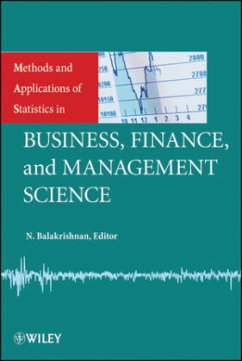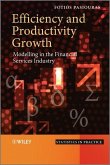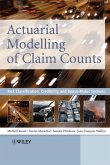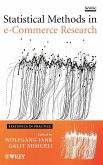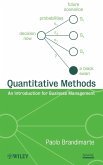Methods and Applications of Statistics in Business, Finance, and Management Science
Ed. by Balakrishnan, N.
Methods and Applications of Statistics in Business, Finance, and Management Science
Ed. by Balakrishnan, N.
- Gebundenes Buch
- Merkliste
- Auf die Merkliste
- Bewerten Bewerten
- Teilen
- Produkt teilen
- Produkterinnerung
- Produkterinnerung
Methods and Applications of Statistics in Business, Finance, and Management Science presents a concise, well-rounded focus on the statistical concepts and applications that are essential for understanding gathered data in these areas. Inspired by the Encyclopedia of Statistical Sciences, Second Edition, this succinct reference features both established ESS2e articles and newly-acquired contributions from over 100 leading experts in academia and industry. Students, academics, and researchers in the fields of business, finance, economics, management science, and the related client disciplines…mehr
Andere Kunden interessierten sich auch für
![Efficiency and Productivity Growth Efficiency and Productivity Growth]() Fotios PasiourasEfficiency and Productivity Growth116,99 €
Fotios PasiourasEfficiency and Productivity Growth116,99 €![Actuarial Modelling of Claim Counts Actuarial Modelling of Claim Counts]() Michel DenuitActuarial Modelling of Claim Counts147,99 €
Michel DenuitActuarial Modelling of Claim Counts147,99 €![Financial Derivative and Energy Market Valuation Financial Derivative and Energy Market Valuation]() Michael MastroFinancial Derivative and Energy Market Valuation169,99 €
Michael MastroFinancial Derivative and Energy Market Valuation169,99 €![Fundamentals of Actuarial Mathematics Fundamentals of Actuarial Mathematics]() S. David PromislowFundamentals of Actuarial Mathematics85,99 €
S. David PromislowFundamentals of Actuarial Mathematics85,99 €![Extremes in Random Fields Extremes in Random Fields]() Benjamin YakirExtremes in Random Fields111,99 €
Benjamin YakirExtremes in Random Fields111,99 €![Methods in eCommerce Research Methods in eCommerce Research]() Wolfgang JankMethods in eCommerce Research164,99 €
Wolfgang JankMethods in eCommerce Research164,99 €![Quantitative Methods Quantitative Methods]() Paolo BrandimarteQuantitative Methods164,99 €
Paolo BrandimarteQuantitative Methods164,99 €-
-
-
Methods and Applications of Statistics in Business, Finance, and Management Science presents a concise, well-rounded focus on the statistical concepts and applications that are essential for understanding gathered data in these areas. Inspired by the Encyclopedia of Statistical Sciences, Second Edition, this succinct reference features both established ESS2e articles and newly-acquired contributions from over 100 leading experts in academia and industry. Students, academics, and researchers in the fields of business, finance, economics, management science, and the related client disciplines will not want to be without this accessible resource.
Inspired by the Encyclopedia of Statistical Sciences, Second Edition, this volume presents the tools and techniques that are essential for carrying out best practices in the modern business world
The collection and analysis of quantitative data drives some of the most important conclusions that are drawn in today's business world, such as the preferences of a customer base, the quality of manufactured products, the marketing of products, and the availability of financial resources. As a result, it is essential for individuals working in this environment to have the knowledge and skills to interpret and use statistical techniques in various scenarios. Addressing this need, Methods and Applications of Statistics in Business, Finance, and Management Science serves as a single, one-of-a-kind resource that guides readers through the use of common statistical practices by presenting real-world applications from the fields of business, economics, finance, operations research, and management science.
Uniting established literature with the latest research, this volume features classic articles from the acclaimed Encyclopedia of Statistical Sciences, Second Edition along with brand-new contributions written by today's leading academics and practitioners. The result is a compilation that explores classic methodology and new topics, including:
Analytical methods for risk management
Statistical modeling for online auctions
Ranking and selection in mutual funds
Uses of Black-Scholes formula in finance
Data mining in prediction markets
From auditing and marketing to stock market price indices and banking, the presented literature sheds light on the use of quantitative methods in research relating to common financial applications. In addition, the book supplies insight on common uses of statistical techniques such as Bayesian methods, optimization, simulation, forecasting, mathematical modeling, financial time series, and data mining in modern research.
Providing a blend of traditional methodology and the latest research, Methods and Applications of Statistics in Business, Finance, and Management Science is an excellent reference for researchers, managers, consultants, and students in the fields of business, management science, operations research, supply chain management, mathematical finance, and economics who must understand statistical literature and carry out quantitative practices to make smart business decisions in their everyday work.
Hinweis: Dieser Artikel kann nur an eine deutsche Lieferadresse ausgeliefert werden.
Inspired by the Encyclopedia of Statistical Sciences, Second Edition, this volume presents the tools and techniques that are essential for carrying out best practices in the modern business world
The collection and analysis of quantitative data drives some of the most important conclusions that are drawn in today's business world, such as the preferences of a customer base, the quality of manufactured products, the marketing of products, and the availability of financial resources. As a result, it is essential for individuals working in this environment to have the knowledge and skills to interpret and use statistical techniques in various scenarios. Addressing this need, Methods and Applications of Statistics in Business, Finance, and Management Science serves as a single, one-of-a-kind resource that guides readers through the use of common statistical practices by presenting real-world applications from the fields of business, economics, finance, operations research, and management science.
Uniting established literature with the latest research, this volume features classic articles from the acclaimed Encyclopedia of Statistical Sciences, Second Edition along with brand-new contributions written by today's leading academics and practitioners. The result is a compilation that explores classic methodology and new topics, including:
Analytical methods for risk management
Statistical modeling for online auctions
Ranking and selection in mutual funds
Uses of Black-Scholes formula in finance
Data mining in prediction markets
From auditing and marketing to stock market price indices and banking, the presented literature sheds light on the use of quantitative methods in research relating to common financial applications. In addition, the book supplies insight on common uses of statistical techniques such as Bayesian methods, optimization, simulation, forecasting, mathematical modeling, financial time series, and data mining in modern research.
Providing a blend of traditional methodology and the latest research, Methods and Applications of Statistics in Business, Finance, and Management Science is an excellent reference for researchers, managers, consultants, and students in the fields of business, management science, operations research, supply chain management, mathematical finance, and economics who must understand statistical literature and carry out quantitative practices to make smart business decisions in their everyday work.
Hinweis: Dieser Artikel kann nur an eine deutsche Lieferadresse ausgeliefert werden.
Produktdetails
- Produktdetails
- Verlag: Wiley & Sons
- Artikelnr. des Verlages: 14540510000
- 1. Auflage
- Seitenzahl: 736
- Erscheinungstermin: 13. Juli 2010
- Englisch
- Abmessung: 257mm x 188mm x 38mm
- Gewicht: 1396g
- ISBN-13: 9780470405109
- ISBN-10: 0470405104
- Artikelnr.: 29338767
- Herstellerkennzeichnung
- Libri GmbH
- Europaallee 1
- 36244 Bad Hersfeld
- gpsr@libri.de
- Verlag: Wiley & Sons
- Artikelnr. des Verlages: 14540510000
- 1. Auflage
- Seitenzahl: 736
- Erscheinungstermin: 13. Juli 2010
- Englisch
- Abmessung: 257mm x 188mm x 38mm
- Gewicht: 1396g
- ISBN-13: 9780470405109
- ISBN-10: 0470405104
- Artikelnr.: 29338767
- Herstellerkennzeichnung
- Libri GmbH
- Europaallee 1
- 36244 Bad Hersfeld
- gpsr@libri.de
N. Balakrishnan, PhD, is Professor in the Department of Mathematics and Statistics at McMaster University, Canada. Dr. Balakrishnan is coeditor of Wiley's Encyclopedia of Statistical Sciences, Second Edition and also serves as Editor in Chief of Communications in Statistics. A Fellow of the American Statistical Association and the Institute of Mathematical Statistics, Dr. Balakrishnan is the coauthor of Precedence-Type Tests and Applications and A Primer on Statistical Distributions, both published by Wiley.
Preface.
Contributors.
1 Alternatives to Black-Scholes Formulation in Finance.
1.1 Introduction.
1.2 Motivation for Alternative Models.
1.3 Methods of Valuation.
1.4 Stochastic Interest-Rate Models.
1.5 Stochastic Volatility Models.
1.6 Models with Lévy Processes.
2 Analytical Methods of Risk Management: An Engineering Systems
Perspective.
2.1 Introduction.
2.2 Risk Management in Engineering Systems.
2.3 Risk Assessment and Analysis.
2.4 Allocating Resources.
2.5 Conclusion.
3 ARCH and GARCH Models.
3.1 Introduction.
3.2 Volatility Clustering.
3.3 GARCH.
3.4 IGARCH.
3.5 EGARCH.
3.6 Alternative Parameterizations.
3.7 Time-Varying Parameter and Bilinear Models.
3.8 Estimation and Inference.
3.9 Testing.
3.10 Empirical Example.
3.11 Future Developments.
4 Bayesian Forecasting.
4.1 Introduction.
4.2 Background.
4.3 Dynamic Bayesian Models.
4.4 Normal Dynamic Linear Models.
4.5 Component Dynamic Linear Models.
4.6 Discounting.
4.7 Intervention.
4.8 Monitoring and Adaptation.
4.9 Mixtures of Dynamic Models.
4.10 Non-normal Nonlinear Models.
4.11 Multivariate Models.
4.12 Computation and Simulation.
4.13 Related Areas.
5 Bayesian Networks.
5.1 Examples and Definitions.
5.2 Constructing Bayesian-Network Models.
5.3 Models Specified by Input Lists.
5.4 Graphically Specified Models.
5.5 Conditionally Specified Models.
5.6 Learning Models from Data.
5.7 Propagation in Bayesian Networks.
5.8 Available Software.
6 Box-Jenkins Model.
6.1 Introduction.
7 Business Forecasting Methods.
7.1 Introduction.
7.2 Trend Curves.
7.3 Exponential Smoothing.
7.4 Exponential Smoothing and Arima Model Building.
7.5 Regression and Econometric Methods.
7.6 Regression and Time-Series Principles.
7.7 Combination of Forecasts.
7.8 Evaluation of Forecasts.
7.9 Summary.
8 Combination of Forecasts.
8.1 Introduction.
8.2 The Theory of Combining.
8.3 Estimators of the Weights.
8.4 An Example.
8.5 Further Extensions.
9 Decision Theory.
9.1 Introduction.
9.2 Parameters, Decisions, and Consequences.
9.3 Utility.
9.4 Components of a Decision Problem.
9.5 Subjective Probability.
9.6 Decision Analysis.
9.7 Statistical Decision Problems.
9.8 Conjugate Families of Prior Distributions.
9.9 Improper Prior Distributions.
9.10 Estimation and Tests of Hypothesis.
9.11 Sequential Decision Problems.
10 Dynamic Programming.
10.1 Introduction.
10.2 Definitions and Examples.
10.3 Some Fundamental Principles.
10.4 The Optimality of Equation and Backward Induction.
10.5 Stationary Plans.
11 Estimation of Travel Distance.
11.1 Introduction.
11.2 Distance Functions.
11.3 Goodness-of-Fit Criteria.
11.4 Areas of Future Research.
12 Financial Time Series.
12.1 Asset Price and Return.
12.2 Fundamental and Technical Analyses.
12.3 Volatility Model.
12.4 High-Frequency Data.
12.5 Continuous-Time Model.
13 Forecasting.
13.1 Introduction.
13.2 Model Components.
13.3 Model Fitting for Forecasting.
13.4 Forecasting Methods.
13.5 Forecast Quality.
14 Foundations of Risk Measurement.
14.1 Introduction.
15 Functional Networks.
15.1 Introduction.
15.2 Elements of Functional Networks.
15.3 Differences Between Standard NNs and FNs.
15.4 Development and Implentation of FNs.
15.5 An Example of Application.
16 Game Theory.
16.1 Introduction.
16.2 Strategies and Payoffs.
16.3 Applications to Statistics.
17 Intervention Model Analysis.
17.1 Introduction.
17.2 Time-Series and Intervention Models.
17.3 Applications and Extensions.
18 Inventory Theory.
18.1 Introduction.
18.2 Historical Background.
18.3 Models with Known Demand.
18.4 Models with Uncertain Demand.
18.5 Conclusion.
19 Manpower Planning.
19.1 Introduction.
19.2 Statistical Analysis of Wastage.
19.3 Markov Models for Graded Systems.
19.4 Renewal Models for Graded Systems.
19.5 Literature.
20 Markov Networks.
20.1 Statement of the Problem.
20.2 Some Basic Concepts of Graphs.
20.3 Constructing Markov Network Models.
20.4 Propagation in markov Networks.
20.5 Available Software.
21 Methods of Estimation of Risks and Analysis of Business Processes.
21.1 Introduction.
21.2 Mathematical Models of Economic Systems in the Form of the Business
Processes Portfolio.
21.3 Risks of Economic Systems.
21.4 Economic Systems Factors Analysis.
22 Mining Functional Data in Prediction Markets.
22.1 Introduction.
22.2 Prediction Markets.
22.3 Data.
22.4 Functional Data Analysis.
22.5 Discussion.
23 Models for Bid Arrivals and Bidder Arrivals in Online Auctions.
23.1 Introduction.
23.2 Motivation.
23.3 Features of Bid Arrivals.
23.4 The BARISTA: A Three-Stage Nohomogeneous Poisson Process.
23.5 Relating Bidder Arrivals and Bid Arrivals.
24 Multiserver Queues.
24.1 Introduction.
24.2 Markovian Queues.
24.3 Non-Markovian Queues.
24.4 Other Methods.
25 Multivariate Time-Series Analysis.
25.1 Introduction.
25.2 Stationary Mutivariate Time Series and Their Covariance Properties.
25.3 Some Spectral Characteristics for Stationary Vector Processes.
25.4 Linear Filtering Relations for Stationary Vector Processes.
25.5 Linear Model Representations for Stationary Vector Processes.
25.6 Vecotr Autoregressive Moving Average (ARMA) Model Representations.
25.7 Nonstationary Vector Autoregressive Moving-Average Models.
25.8 Forecasting for Vector Autoregressive Moving-Average Processes.
25.9 Statistical Analysis of Vector Autoregressive Moving-Average Models.
26 Network Analysis.
26.1 Introduction.
27 Network of Queues.
27.1 Introduction.
27.2 Some Background.
27.3 Some Results.
27.4 More General Networks.
27.5 Sojourn Times in Queueing Networks.
27.6 Customer Flow in Networks.
27.7 Other Approaches and Topics.
28 Neural Networks.
28.1 Introduction.
28.2 Feed-Forward Networks.
28.3 Recurrent Networks.
28.4 Associative-Memory Networks and Boltzmann Machines.
28.5 Networks Trained by Unsupervised Learning.
28.6 Use of the Bayesian Approach.
28.7 Conclusion.
29 Newsboy Inventory Problem.
29.1 Introduction.
30 Nonlinear Time Series.
30.1 Introduction.
30.2 Reviews of Linear Time Series.
30.3 Nonparametric Methods.
30.4 Parametric Models.
30.5 Other Surveys and Comparisons.
31 Nonstationary Time Series.
31.1 Introduction.
31.2 Removing Nonstationary Menas and Variances.
31.3 Extensions.
31.4 Homogeneous and Explosive Nonstationarity.
31.5 Differencing.
31.6 Starting Values and Nonstationarity.
31.7 ARIMA Models.
31.8 Sample Autocorrelations--Identifying the Degree of Differencing.
31.9 Estimation of Unit and Explosive Roots.
31.10 Forecasting.
31.11 Variations and Extensions.
31.12 Nonstationary Spectral Analysis.
32 PERT.
32.1 Introduction.
32.2 Finding the Expected Critical Path Length.
32.3 Simulation and Statistical Computations.
32.4 Estimation of Individual Activity Times.
32.5 Conclusions.
33 Prediction and Forecasting.
33.1 Introduction.
33.2 Regression Models.
33.3 Regression and Smoothing Methods for Extrapolating a Single Time
Series.
33.4 Forecasts from Univariate Time-Series Models.
33.5 Forecasts from Multivariate Time-Series Models.
33.6 State-Space Models, Kalman Flitering and Bayesian Forecasting.
33.7 Econometric Models.
33.8 Input-Output Tables.
33.9 Turning Points and Business Cycle Indicators.
33.10 Surveys of Anticipations and Intentions.
33.11 Combination of Forecasts.
33.12 Prediction of Qualitative Characteristics.
33.13 Forecast Quality and the Evaluation of Forecasts.
34 Pricing Foreign Exchange Options with Stochastic Volatility.
34.1 Introduction.
34.2 Arbitrage-Free Cross-Currency Markets.
34.3 Stein and Stein Stochastic Volatility Model with Vasicêk Interest
Rates.
34.4 Heston's Stochastic Volatility Model with CIR Interest Rates.
34.5 Foreign Exchange Option under Heston Volatility with Constant Interest
Rates.
34.6 Concluding Remarks.
35 Probabilistic Expert Systems.
35.1 Introduction.
35.2 Graph Types.
35.3 Conditioal Independence and Markov Properties.
35.4 Specification of Joint Distribution.
35.5 Local Computation Algorithm.
35.6 Extensions.
36 Problem Solving in Statistics.
36.1 Introduction.
36.2 Phase 1: Study Design.
36.3 Phase 2: Data Collection.
36.4 Phase 3: Data Analysis.
36.5 Postprocess Responsibilities.
36.6 Conclusions.
37 Queueing Theory.
37.1 Introduction.
37.2 Subsequent Development of the Simple Queue Model.
37.3 Variants of the Simple Queueing Model.
37.4 Concluding Remarks.
38 Queues and Networks.
38.1 Introduction.
38.2 A Glimpse on Queueing Theory by Example.
38.3 The Vocabulary of Queueing Theory.
38.4 Little's Formulas.
38.5 Markovian Queueing Systems of BD Type.
38.6 General Service Times: The System M/G/1.
38.7 The Systems M/G/c and G/G/c.
38.8 Networks of Queues.
38.9 Approximations and Numerical Methods.
38.10 Simulation.
39 Ranking and Selection Among Mutual Funds.
39.1 Introduction.
39.2 Statistical Underpinnings of Data Mining Using Combinatorial Fusion
Algorithm.
39.3 Stochastic Dominance and Asymmetric Attitude Towards Risk.
39.4 Summary and Final Remarks.
40 Risk Theory.
40.1 Introduction.
41 Statistical Consulting.
41.1 Definition.
41.2 What Consultants Do.
41.3 Historical Perspective.
41.4 Skills Needed by a Consultant.
41.5 Consulting and Communication.
41.6 Computers and Consultants.
41.7 Keeping Up with Statistics.
41.8 Ethics.
41.9 Teaching Consulting.
41.10 Rewards of Consulting.
42 Statistical Methods in Inventory Effect and Analysis.
42.1 Introduction.
42.2 Futures Markets.
42.3 Backwardation and Inventory Effect.
42.4 Inventory Effect: A Preliminary Analysis.
42.5 Ordered Bivariate Normal Distribution.
42.6 Bivariate Lognormal Distribution.
42.7 Ordered Bivariate Lognormal Distribution.
42.8 Conclusions.
43 Statistical Methods in Risk Management by Futures Clearinghouses.
43.1 Introduction.
43.2 Margin Requirements.
43.3 Settlement Frequency.
43.4 Capital Requirements.
43.5 Price Limits.
43.6 Position Limits.
43.7 Conclusion.
44 Statistics in Auditing.
44.1 Introduction.
44.2 Study of Internal Control System.
44.3 Study of Account Balances.
44.4 Analytical Review.
45 Statistics in Banking.
45.1 Introduction.
45.2 Further Reading.
46 Statistics in Finance.
46.1 Introduction.
46.2 Regression Analysis and the Market Model.
46.3 Factor, Multiple Discriminant and Logit Applications.
46.4 Time-Series Analyses of Financial Information.
46.5 Statistical Decision Theory and Finance.
47 Statistics in Management Science.
47.1 Introduction.
47.2 Using Regression to Estimate Managerial Decision Rules.
47.3 Using Regression for Input Data in Modeling.
47.4 Construction of Causal Models by Regression.
47.5 Statistical Analysis of Algorithmic Performance Data.
47.6 Sampling Theory.
47.7 Other Statistical Tools.
48 Statistics in Marketing.
48.1 Introduction.
48.2 Some Early Contributions.
48.3 The Uses of Statistics in Marketing Research.
48.4 Sample Survey Methods.
48.5 Multivariate Techniques.
48.6 Forecasting Methods.
48.7 Psychometric Methods in the Measurement of Consumer Perceptions and
Preferences.
48.8 Experimentation.
48.9 Probability Models.
49 Statistics of Risk Management.
49.1 Introduction.
49.2 General Concept of Risk Management and Monitoring.
49.3 Scope.
49.4 Evolution of Risk Management.
49.5 Insurance.
49.6 Gambling, Capital Budgeting and Investments.
49.7 Technological Risk Management.
49.8 Low-Probability-High-Consequence Risk Management.
49.9 Environmental Risk and Monitoring Systems.
49.10 Epidemiology and Disease Detection.
49.11 Principles of Statistical Monitoring.
50 Stochastic Differential Equations: Applications in Economics and
Management Science.
50.1 Introduction.
50.2 Option Pricing.
50.3 Stochastic Optimal Control.
50.4 Final Remarks.
51 Stochastic Games.
51.1 Introduction.
51.2 Special Cases.
51.3 Computation.
52 Stock Market Price Indexes.
52.1 Introduction.
52.2 Definition and Uses.
52.3 Brief History.
52.4 Main Issues.
52.5 A Numerical Example.
52.6 Two Major Stock Market Price Indexes.
52.7 The S&P 500.
52.8 Comparison of Four International Indexes.
52.9 Stock Market Indexes and Portfolio Analysis.
52.10 Summary.
53 The Black-Scholes Formula and Its Applications in Finance.
53.1 Introduction.
53.2 The Black-Scholes Model.
53.3 European Call and Put Options.
53.4 Some Exotic Options.
53.5 American Options.
53.6 Application to the Modeling of Credit Risk.
53.7 Real Options.
54 Time Series.
54.1 Introduction.
54.2 Examples of Time Series.
54.3 A Historical Perspective.
54.4 Stationarity.
54.5 The Frequency Domain.
54.6 The Time Domain.
54.7 State-Space Models.
54.8 Transfer Functions and Interventions.
54.9 Other Topics.
54.10 Literature.
54.11 Computer Programs.
54.12 Future Developments.
Index.
Contributors.
1 Alternatives to Black-Scholes Formulation in Finance.
1.1 Introduction.
1.2 Motivation for Alternative Models.
1.3 Methods of Valuation.
1.4 Stochastic Interest-Rate Models.
1.5 Stochastic Volatility Models.
1.6 Models with Lévy Processes.
2 Analytical Methods of Risk Management: An Engineering Systems
Perspective.
2.1 Introduction.
2.2 Risk Management in Engineering Systems.
2.3 Risk Assessment and Analysis.
2.4 Allocating Resources.
2.5 Conclusion.
3 ARCH and GARCH Models.
3.1 Introduction.
3.2 Volatility Clustering.
3.3 GARCH.
3.4 IGARCH.
3.5 EGARCH.
3.6 Alternative Parameterizations.
3.7 Time-Varying Parameter and Bilinear Models.
3.8 Estimation and Inference.
3.9 Testing.
3.10 Empirical Example.
3.11 Future Developments.
4 Bayesian Forecasting.
4.1 Introduction.
4.2 Background.
4.3 Dynamic Bayesian Models.
4.4 Normal Dynamic Linear Models.
4.5 Component Dynamic Linear Models.
4.6 Discounting.
4.7 Intervention.
4.8 Monitoring and Adaptation.
4.9 Mixtures of Dynamic Models.
4.10 Non-normal Nonlinear Models.
4.11 Multivariate Models.
4.12 Computation and Simulation.
4.13 Related Areas.
5 Bayesian Networks.
5.1 Examples and Definitions.
5.2 Constructing Bayesian-Network Models.
5.3 Models Specified by Input Lists.
5.4 Graphically Specified Models.
5.5 Conditionally Specified Models.
5.6 Learning Models from Data.
5.7 Propagation in Bayesian Networks.
5.8 Available Software.
6 Box-Jenkins Model.
6.1 Introduction.
7 Business Forecasting Methods.
7.1 Introduction.
7.2 Trend Curves.
7.3 Exponential Smoothing.
7.4 Exponential Smoothing and Arima Model Building.
7.5 Regression and Econometric Methods.
7.6 Regression and Time-Series Principles.
7.7 Combination of Forecasts.
7.8 Evaluation of Forecasts.
7.9 Summary.
8 Combination of Forecasts.
8.1 Introduction.
8.2 The Theory of Combining.
8.3 Estimators of the Weights.
8.4 An Example.
8.5 Further Extensions.
9 Decision Theory.
9.1 Introduction.
9.2 Parameters, Decisions, and Consequences.
9.3 Utility.
9.4 Components of a Decision Problem.
9.5 Subjective Probability.
9.6 Decision Analysis.
9.7 Statistical Decision Problems.
9.8 Conjugate Families of Prior Distributions.
9.9 Improper Prior Distributions.
9.10 Estimation and Tests of Hypothesis.
9.11 Sequential Decision Problems.
10 Dynamic Programming.
10.1 Introduction.
10.2 Definitions and Examples.
10.3 Some Fundamental Principles.
10.4 The Optimality of Equation and Backward Induction.
10.5 Stationary Plans.
11 Estimation of Travel Distance.
11.1 Introduction.
11.2 Distance Functions.
11.3 Goodness-of-Fit Criteria.
11.4 Areas of Future Research.
12 Financial Time Series.
12.1 Asset Price and Return.
12.2 Fundamental and Technical Analyses.
12.3 Volatility Model.
12.4 High-Frequency Data.
12.5 Continuous-Time Model.
13 Forecasting.
13.1 Introduction.
13.2 Model Components.
13.3 Model Fitting for Forecasting.
13.4 Forecasting Methods.
13.5 Forecast Quality.
14 Foundations of Risk Measurement.
14.1 Introduction.
15 Functional Networks.
15.1 Introduction.
15.2 Elements of Functional Networks.
15.3 Differences Between Standard NNs and FNs.
15.4 Development and Implentation of FNs.
15.5 An Example of Application.
16 Game Theory.
16.1 Introduction.
16.2 Strategies and Payoffs.
16.3 Applications to Statistics.
17 Intervention Model Analysis.
17.1 Introduction.
17.2 Time-Series and Intervention Models.
17.3 Applications and Extensions.
18 Inventory Theory.
18.1 Introduction.
18.2 Historical Background.
18.3 Models with Known Demand.
18.4 Models with Uncertain Demand.
18.5 Conclusion.
19 Manpower Planning.
19.1 Introduction.
19.2 Statistical Analysis of Wastage.
19.3 Markov Models for Graded Systems.
19.4 Renewal Models for Graded Systems.
19.5 Literature.
20 Markov Networks.
20.1 Statement of the Problem.
20.2 Some Basic Concepts of Graphs.
20.3 Constructing Markov Network Models.
20.4 Propagation in markov Networks.
20.5 Available Software.
21 Methods of Estimation of Risks and Analysis of Business Processes.
21.1 Introduction.
21.2 Mathematical Models of Economic Systems in the Form of the Business
Processes Portfolio.
21.3 Risks of Economic Systems.
21.4 Economic Systems Factors Analysis.
22 Mining Functional Data in Prediction Markets.
22.1 Introduction.
22.2 Prediction Markets.
22.3 Data.
22.4 Functional Data Analysis.
22.5 Discussion.
23 Models for Bid Arrivals and Bidder Arrivals in Online Auctions.
23.1 Introduction.
23.2 Motivation.
23.3 Features of Bid Arrivals.
23.4 The BARISTA: A Three-Stage Nohomogeneous Poisson Process.
23.5 Relating Bidder Arrivals and Bid Arrivals.
24 Multiserver Queues.
24.1 Introduction.
24.2 Markovian Queues.
24.3 Non-Markovian Queues.
24.4 Other Methods.
25 Multivariate Time-Series Analysis.
25.1 Introduction.
25.2 Stationary Mutivariate Time Series and Their Covariance Properties.
25.3 Some Spectral Characteristics for Stationary Vector Processes.
25.4 Linear Filtering Relations for Stationary Vector Processes.
25.5 Linear Model Representations for Stationary Vector Processes.
25.6 Vecotr Autoregressive Moving Average (ARMA) Model Representations.
25.7 Nonstationary Vector Autoregressive Moving-Average Models.
25.8 Forecasting for Vector Autoregressive Moving-Average Processes.
25.9 Statistical Analysis of Vector Autoregressive Moving-Average Models.
26 Network Analysis.
26.1 Introduction.
27 Network of Queues.
27.1 Introduction.
27.2 Some Background.
27.3 Some Results.
27.4 More General Networks.
27.5 Sojourn Times in Queueing Networks.
27.6 Customer Flow in Networks.
27.7 Other Approaches and Topics.
28 Neural Networks.
28.1 Introduction.
28.2 Feed-Forward Networks.
28.3 Recurrent Networks.
28.4 Associative-Memory Networks and Boltzmann Machines.
28.5 Networks Trained by Unsupervised Learning.
28.6 Use of the Bayesian Approach.
28.7 Conclusion.
29 Newsboy Inventory Problem.
29.1 Introduction.
30 Nonlinear Time Series.
30.1 Introduction.
30.2 Reviews of Linear Time Series.
30.3 Nonparametric Methods.
30.4 Parametric Models.
30.5 Other Surveys and Comparisons.
31 Nonstationary Time Series.
31.1 Introduction.
31.2 Removing Nonstationary Menas and Variances.
31.3 Extensions.
31.4 Homogeneous and Explosive Nonstationarity.
31.5 Differencing.
31.6 Starting Values and Nonstationarity.
31.7 ARIMA Models.
31.8 Sample Autocorrelations--Identifying the Degree of Differencing.
31.9 Estimation of Unit and Explosive Roots.
31.10 Forecasting.
31.11 Variations and Extensions.
31.12 Nonstationary Spectral Analysis.
32 PERT.
32.1 Introduction.
32.2 Finding the Expected Critical Path Length.
32.3 Simulation and Statistical Computations.
32.4 Estimation of Individual Activity Times.
32.5 Conclusions.
33 Prediction and Forecasting.
33.1 Introduction.
33.2 Regression Models.
33.3 Regression and Smoothing Methods for Extrapolating a Single Time
Series.
33.4 Forecasts from Univariate Time-Series Models.
33.5 Forecasts from Multivariate Time-Series Models.
33.6 State-Space Models, Kalman Flitering and Bayesian Forecasting.
33.7 Econometric Models.
33.8 Input-Output Tables.
33.9 Turning Points and Business Cycle Indicators.
33.10 Surveys of Anticipations and Intentions.
33.11 Combination of Forecasts.
33.12 Prediction of Qualitative Characteristics.
33.13 Forecast Quality and the Evaluation of Forecasts.
34 Pricing Foreign Exchange Options with Stochastic Volatility.
34.1 Introduction.
34.2 Arbitrage-Free Cross-Currency Markets.
34.3 Stein and Stein Stochastic Volatility Model with Vasicêk Interest
Rates.
34.4 Heston's Stochastic Volatility Model with CIR Interest Rates.
34.5 Foreign Exchange Option under Heston Volatility with Constant Interest
Rates.
34.6 Concluding Remarks.
35 Probabilistic Expert Systems.
35.1 Introduction.
35.2 Graph Types.
35.3 Conditioal Independence and Markov Properties.
35.4 Specification of Joint Distribution.
35.5 Local Computation Algorithm.
35.6 Extensions.
36 Problem Solving in Statistics.
36.1 Introduction.
36.2 Phase 1: Study Design.
36.3 Phase 2: Data Collection.
36.4 Phase 3: Data Analysis.
36.5 Postprocess Responsibilities.
36.6 Conclusions.
37 Queueing Theory.
37.1 Introduction.
37.2 Subsequent Development of the Simple Queue Model.
37.3 Variants of the Simple Queueing Model.
37.4 Concluding Remarks.
38 Queues and Networks.
38.1 Introduction.
38.2 A Glimpse on Queueing Theory by Example.
38.3 The Vocabulary of Queueing Theory.
38.4 Little's Formulas.
38.5 Markovian Queueing Systems of BD Type.
38.6 General Service Times: The System M/G/1.
38.7 The Systems M/G/c and G/G/c.
38.8 Networks of Queues.
38.9 Approximations and Numerical Methods.
38.10 Simulation.
39 Ranking and Selection Among Mutual Funds.
39.1 Introduction.
39.2 Statistical Underpinnings of Data Mining Using Combinatorial Fusion
Algorithm.
39.3 Stochastic Dominance and Asymmetric Attitude Towards Risk.
39.4 Summary and Final Remarks.
40 Risk Theory.
40.1 Introduction.
41 Statistical Consulting.
41.1 Definition.
41.2 What Consultants Do.
41.3 Historical Perspective.
41.4 Skills Needed by a Consultant.
41.5 Consulting and Communication.
41.6 Computers and Consultants.
41.7 Keeping Up with Statistics.
41.8 Ethics.
41.9 Teaching Consulting.
41.10 Rewards of Consulting.
42 Statistical Methods in Inventory Effect and Analysis.
42.1 Introduction.
42.2 Futures Markets.
42.3 Backwardation and Inventory Effect.
42.4 Inventory Effect: A Preliminary Analysis.
42.5 Ordered Bivariate Normal Distribution.
42.6 Bivariate Lognormal Distribution.
42.7 Ordered Bivariate Lognormal Distribution.
42.8 Conclusions.
43 Statistical Methods in Risk Management by Futures Clearinghouses.
43.1 Introduction.
43.2 Margin Requirements.
43.3 Settlement Frequency.
43.4 Capital Requirements.
43.5 Price Limits.
43.6 Position Limits.
43.7 Conclusion.
44 Statistics in Auditing.
44.1 Introduction.
44.2 Study of Internal Control System.
44.3 Study of Account Balances.
44.4 Analytical Review.
45 Statistics in Banking.
45.1 Introduction.
45.2 Further Reading.
46 Statistics in Finance.
46.1 Introduction.
46.2 Regression Analysis and the Market Model.
46.3 Factor, Multiple Discriminant and Logit Applications.
46.4 Time-Series Analyses of Financial Information.
46.5 Statistical Decision Theory and Finance.
47 Statistics in Management Science.
47.1 Introduction.
47.2 Using Regression to Estimate Managerial Decision Rules.
47.3 Using Regression for Input Data in Modeling.
47.4 Construction of Causal Models by Regression.
47.5 Statistical Analysis of Algorithmic Performance Data.
47.6 Sampling Theory.
47.7 Other Statistical Tools.
48 Statistics in Marketing.
48.1 Introduction.
48.2 Some Early Contributions.
48.3 The Uses of Statistics in Marketing Research.
48.4 Sample Survey Methods.
48.5 Multivariate Techniques.
48.6 Forecasting Methods.
48.7 Psychometric Methods in the Measurement of Consumer Perceptions and
Preferences.
48.8 Experimentation.
48.9 Probability Models.
49 Statistics of Risk Management.
49.1 Introduction.
49.2 General Concept of Risk Management and Monitoring.
49.3 Scope.
49.4 Evolution of Risk Management.
49.5 Insurance.
49.6 Gambling, Capital Budgeting and Investments.
49.7 Technological Risk Management.
49.8 Low-Probability-High-Consequence Risk Management.
49.9 Environmental Risk and Monitoring Systems.
49.10 Epidemiology and Disease Detection.
49.11 Principles of Statistical Monitoring.
50 Stochastic Differential Equations: Applications in Economics and
Management Science.
50.1 Introduction.
50.2 Option Pricing.
50.3 Stochastic Optimal Control.
50.4 Final Remarks.
51 Stochastic Games.
51.1 Introduction.
51.2 Special Cases.
51.3 Computation.
52 Stock Market Price Indexes.
52.1 Introduction.
52.2 Definition and Uses.
52.3 Brief History.
52.4 Main Issues.
52.5 A Numerical Example.
52.6 Two Major Stock Market Price Indexes.
52.7 The S&P 500.
52.8 Comparison of Four International Indexes.
52.9 Stock Market Indexes and Portfolio Analysis.
52.10 Summary.
53 The Black-Scholes Formula and Its Applications in Finance.
53.1 Introduction.
53.2 The Black-Scholes Model.
53.3 European Call and Put Options.
53.4 Some Exotic Options.
53.5 American Options.
53.6 Application to the Modeling of Credit Risk.
53.7 Real Options.
54 Time Series.
54.1 Introduction.
54.2 Examples of Time Series.
54.3 A Historical Perspective.
54.4 Stationarity.
54.5 The Frequency Domain.
54.6 The Time Domain.
54.7 State-Space Models.
54.8 Transfer Functions and Interventions.
54.9 Other Topics.
54.10 Literature.
54.11 Computer Programs.
54.12 Future Developments.
Index.
Preface.
Contributors.
1 Alternatives to Black-Scholes Formulation in Finance.
1.1 Introduction.
1.2 Motivation for Alternative Models.
1.3 Methods of Valuation.
1.4 Stochastic Interest-Rate Models.
1.5 Stochastic Volatility Models.
1.6 Models with Lévy Processes.
2 Analytical Methods of Risk Management: An Engineering Systems
Perspective.
2.1 Introduction.
2.2 Risk Management in Engineering Systems.
2.3 Risk Assessment and Analysis.
2.4 Allocating Resources.
2.5 Conclusion.
3 ARCH and GARCH Models.
3.1 Introduction.
3.2 Volatility Clustering.
3.3 GARCH.
3.4 IGARCH.
3.5 EGARCH.
3.6 Alternative Parameterizations.
3.7 Time-Varying Parameter and Bilinear Models.
3.8 Estimation and Inference.
3.9 Testing.
3.10 Empirical Example.
3.11 Future Developments.
4 Bayesian Forecasting.
4.1 Introduction.
4.2 Background.
4.3 Dynamic Bayesian Models.
4.4 Normal Dynamic Linear Models.
4.5 Component Dynamic Linear Models.
4.6 Discounting.
4.7 Intervention.
4.8 Monitoring and Adaptation.
4.9 Mixtures of Dynamic Models.
4.10 Non-normal Nonlinear Models.
4.11 Multivariate Models.
4.12 Computation and Simulation.
4.13 Related Areas.
5 Bayesian Networks.
5.1 Examples and Definitions.
5.2 Constructing Bayesian-Network Models.
5.3 Models Specified by Input Lists.
5.4 Graphically Specified Models.
5.5 Conditionally Specified Models.
5.6 Learning Models from Data.
5.7 Propagation in Bayesian Networks.
5.8 Available Software.
6 Box-Jenkins Model.
6.1 Introduction.
7 Business Forecasting Methods.
7.1 Introduction.
7.2 Trend Curves.
7.3 Exponential Smoothing.
7.4 Exponential Smoothing and Arima Model Building.
7.5 Regression and Econometric Methods.
7.6 Regression and Time-Series Principles.
7.7 Combination of Forecasts.
7.8 Evaluation of Forecasts.
7.9 Summary.
8 Combination of Forecasts.
8.1 Introduction.
8.2 The Theory of Combining.
8.3 Estimators of the Weights.
8.4 An Example.
8.5 Further Extensions.
9 Decision Theory.
9.1 Introduction.
9.2 Parameters, Decisions, and Consequences.
9.3 Utility.
9.4 Components of a Decision Problem.
9.5 Subjective Probability.
9.6 Decision Analysis.
9.7 Statistical Decision Problems.
9.8 Conjugate Families of Prior Distributions.
9.9 Improper Prior Distributions.
9.10 Estimation and Tests of Hypothesis.
9.11 Sequential Decision Problems.
10 Dynamic Programming.
10.1 Introduction.
10.2 Definitions and Examples.
10.3 Some Fundamental Principles.
10.4 The Optimality of Equation and Backward Induction.
10.5 Stationary Plans.
11 Estimation of Travel Distance.
11.1 Introduction.
11.2 Distance Functions.
11.3 Goodness-of-Fit Criteria.
11.4 Areas of Future Research.
12 Financial Time Series.
12.1 Asset Price and Return.
12.2 Fundamental and Technical Analyses.
12.3 Volatility Model.
12.4 High-Frequency Data.
12.5 Continuous-Time Model.
13 Forecasting.
13.1 Introduction.
13.2 Model Components.
13.3 Model Fitting for Forecasting.
13.4 Forecasting Methods.
13.5 Forecast Quality.
14 Foundations of Risk Measurement.
14.1 Introduction.
15 Functional Networks.
15.1 Introduction.
15.2 Elements of Functional Networks.
15.3 Differences Between Standard NNs and FNs.
15.4 Development and Implentation of FNs.
15.5 An Example of Application.
16 Game Theory.
16.1 Introduction.
16.2 Strategies and Payoffs.
16.3 Applications to Statistics.
17 Intervention Model Analysis.
17.1 Introduction.
17.2 Time-Series and Intervention Models.
17.3 Applications and Extensions.
18 Inventory Theory.
18.1 Introduction.
18.2 Historical Background.
18.3 Models with Known Demand.
18.4 Models with Uncertain Demand.
18.5 Conclusion.
19 Manpower Planning.
19.1 Introduction.
19.2 Statistical Analysis of Wastage.
19.3 Markov Models for Graded Systems.
19.4 Renewal Models for Graded Systems.
19.5 Literature.
20 Markov Networks.
20.1 Statement of the Problem.
20.2 Some Basic Concepts of Graphs.
20.3 Constructing Markov Network Models.
20.4 Propagation in markov Networks.
20.5 Available Software.
21 Methods of Estimation of Risks and Analysis of Business Processes.
21.1 Introduction.
21.2 Mathematical Models of Economic Systems in the Form of the Business
Processes Portfolio.
21.3 Risks of Economic Systems.
21.4 Economic Systems Factors Analysis.
22 Mining Functional Data in Prediction Markets.
22.1 Introduction.
22.2 Prediction Markets.
22.3 Data.
22.4 Functional Data Analysis.
22.5 Discussion.
23 Models for Bid Arrivals and Bidder Arrivals in Online Auctions.
23.1 Introduction.
23.2 Motivation.
23.3 Features of Bid Arrivals.
23.4 The BARISTA: A Three-Stage Nohomogeneous Poisson Process.
23.5 Relating Bidder Arrivals and Bid Arrivals.
24 Multiserver Queues.
24.1 Introduction.
24.2 Markovian Queues.
24.3 Non-Markovian Queues.
24.4 Other Methods.
25 Multivariate Time-Series Analysis.
25.1 Introduction.
25.2 Stationary Mutivariate Time Series and Their Covariance Properties.
25.3 Some Spectral Characteristics for Stationary Vector Processes.
25.4 Linear Filtering Relations for Stationary Vector Processes.
25.5 Linear Model Representations for Stationary Vector Processes.
25.6 Vecotr Autoregressive Moving Average (ARMA) Model Representations.
25.7 Nonstationary Vector Autoregressive Moving-Average Models.
25.8 Forecasting for Vector Autoregressive Moving-Average Processes.
25.9 Statistical Analysis of Vector Autoregressive Moving-Average Models.
26 Network Analysis.
26.1 Introduction.
27 Network of Queues.
27.1 Introduction.
27.2 Some Background.
27.3 Some Results.
27.4 More General Networks.
27.5 Sojourn Times in Queueing Networks.
27.6 Customer Flow in Networks.
27.7 Other Approaches and Topics.
28 Neural Networks.
28.1 Introduction.
28.2 Feed-Forward Networks.
28.3 Recurrent Networks.
28.4 Associative-Memory Networks and Boltzmann Machines.
28.5 Networks Trained by Unsupervised Learning.
28.6 Use of the Bayesian Approach.
28.7 Conclusion.
29 Newsboy Inventory Problem.
29.1 Introduction.
30 Nonlinear Time Series.
30.1 Introduction.
30.2 Reviews of Linear Time Series.
30.3 Nonparametric Methods.
30.4 Parametric Models.
30.5 Other Surveys and Comparisons.
31 Nonstationary Time Series.
31.1 Introduction.
31.2 Removing Nonstationary Menas and Variances.
31.3 Extensions.
31.4 Homogeneous and Explosive Nonstationarity.
31.5 Differencing.
31.6 Starting Values and Nonstationarity.
31.7 ARIMA Models.
31.8 Sample Autocorrelations--Identifying the Degree of Differencing.
31.9 Estimation of Unit and Explosive Roots.
31.10 Forecasting.
31.11 Variations and Extensions.
31.12 Nonstationary Spectral Analysis.
32 PERT.
32.1 Introduction.
32.2 Finding the Expected Critical Path Length.
32.3 Simulation and Statistical Computations.
32.4 Estimation of Individual Activity Times.
32.5 Conclusions.
33 Prediction and Forecasting.
33.1 Introduction.
33.2 Regression Models.
33.3 Regression and Smoothing Methods for Extrapolating a Single Time
Series.
33.4 Forecasts from Univariate Time-Series Models.
33.5 Forecasts from Multivariate Time-Series Models.
33.6 State-Space Models, Kalman Flitering and Bayesian Forecasting.
33.7 Econometric Models.
33.8 Input-Output Tables.
33.9 Turning Points and Business Cycle Indicators.
33.10 Surveys of Anticipations and Intentions.
33.11 Combination of Forecasts.
33.12 Prediction of Qualitative Characteristics.
33.13 Forecast Quality and the Evaluation of Forecasts.
34 Pricing Foreign Exchange Options with Stochastic Volatility.
34.1 Introduction.
34.2 Arbitrage-Free Cross-Currency Markets.
34.3 Stein and Stein Stochastic Volatility Model with Vasicêk Interest
Rates.
34.4 Heston's Stochastic Volatility Model with CIR Interest Rates.
34.5 Foreign Exchange Option under Heston Volatility with Constant Interest
Rates.
34.6 Concluding Remarks.
35 Probabilistic Expert Systems.
35.1 Introduction.
35.2 Graph Types.
35.3 Conditioal Independence and Markov Properties.
35.4 Specification of Joint Distribution.
35.5 Local Computation Algorithm.
35.6 Extensions.
36 Problem Solving in Statistics.
36.1 Introduction.
36.2 Phase 1: Study Design.
36.3 Phase 2: Data Collection.
36.4 Phase 3: Data Analysis.
36.5 Postprocess Responsibilities.
36.6 Conclusions.
37 Queueing Theory.
37.1 Introduction.
37.2 Subsequent Development of the Simple Queue Model.
37.3 Variants of the Simple Queueing Model.
37.4 Concluding Remarks.
38 Queues and Networks.
38.1 Introduction.
38.2 A Glimpse on Queueing Theory by Example.
38.3 The Vocabulary of Queueing Theory.
38.4 Little's Formulas.
38.5 Markovian Queueing Systems of BD Type.
38.6 General Service Times: The System M/G/1.
38.7 The Systems M/G/c and G/G/c.
38.8 Networks of Queues.
38.9 Approximations and Numerical Methods.
38.10 Simulation.
39 Ranking and Selection Among Mutual Funds.
39.1 Introduction.
39.2 Statistical Underpinnings of Data Mining Using Combinatorial Fusion
Algorithm.
39.3 Stochastic Dominance and Asymmetric Attitude Towards Risk.
39.4 Summary and Final Remarks.
40 Risk Theory.
40.1 Introduction.
41 Statistical Consulting.
41.1 Definition.
41.2 What Consultants Do.
41.3 Historical Perspective.
41.4 Skills Needed by a Consultant.
41.5 Consulting and Communication.
41.6 Computers and Consultants.
41.7 Keeping Up with Statistics.
41.8 Ethics.
41.9 Teaching Consulting.
41.10 Rewards of Consulting.
42 Statistical Methods in Inventory Effect and Analysis.
42.1 Introduction.
42.2 Futures Markets.
42.3 Backwardation and Inventory Effect.
42.4 Inventory Effect: A Preliminary Analysis.
42.5 Ordered Bivariate Normal Distribution.
42.6 Bivariate Lognormal Distribution.
42.7 Ordered Bivariate Lognormal Distribution.
42.8 Conclusions.
43 Statistical Methods in Risk Management by Futures Clearinghouses.
43.1 Introduction.
43.2 Margin Requirements.
43.3 Settlement Frequency.
43.4 Capital Requirements.
43.5 Price Limits.
43.6 Position Limits.
43.7 Conclusion.
44 Statistics in Auditing.
44.1 Introduction.
44.2 Study of Internal Control System.
44.3 Study of Account Balances.
44.4 Analytical Review.
45 Statistics in Banking.
45.1 Introduction.
45.2 Further Reading.
46 Statistics in Finance.
46.1 Introduction.
46.2 Regression Analysis and the Market Model.
46.3 Factor, Multiple Discriminant and Logit Applications.
46.4 Time-Series Analyses of Financial Information.
46.5 Statistical Decision Theory and Finance.
47 Statistics in Management Science.
47.1 Introduction.
47.2 Using Regression to Estimate Managerial Decision Rules.
47.3 Using Regression for Input Data in Modeling.
47.4 Construction of Causal Models by Regression.
47.5 Statistical Analysis of Algorithmic Performance Data.
47.6 Sampling Theory.
47.7 Other Statistical Tools.
48 Statistics in Marketing.
48.1 Introduction.
48.2 Some Early Contributions.
48.3 The Uses of Statistics in Marketing Research.
48.4 Sample Survey Methods.
48.5 Multivariate Techniques.
48.6 Forecasting Methods.
48.7 Psychometric Methods in the Measurement of Consumer Perceptions and
Preferences.
48.8 Experimentation.
48.9 Probability Models.
49 Statistics of Risk Management.
49.1 Introduction.
49.2 General Concept of Risk Management and Monitoring.
49.3 Scope.
49.4 Evolution of Risk Management.
49.5 Insurance.
49.6 Gambling, Capital Budgeting and Investments.
49.7 Technological Risk Management.
49.8 Low-Probability-High-Consequence Risk Management.
49.9 Environmental Risk and Monitoring Systems.
49.10 Epidemiology and Disease Detection.
49.11 Principles of Statistical Monitoring.
50 Stochastic Differential Equations: Applications in Economics and
Management Science.
50.1 Introduction.
50.2 Option Pricing.
50.3 Stochastic Optimal Control.
50.4 Final Remarks.
51 Stochastic Games.
51.1 Introduction.
51.2 Special Cases.
51.3 Computation.
52 Stock Market Price Indexes.
52.1 Introduction.
52.2 Definition and Uses.
52.3 Brief History.
52.4 Main Issues.
52.5 A Numerical Example.
52.6 Two Major Stock Market Price Indexes.
52.7 The S&P 500.
52.8 Comparison of Four International Indexes.
52.9 Stock Market Indexes and Portfolio Analysis.
52.10 Summary.
53 The Black-Scholes Formula and Its Applications in Finance.
53.1 Introduction.
53.2 The Black-Scholes Model.
53.3 European Call and Put Options.
53.4 Some Exotic Options.
53.5 American Options.
53.6 Application to the Modeling of Credit Risk.
53.7 Real Options.
54 Time Series.
54.1 Introduction.
54.2 Examples of Time Series.
54.3 A Historical Perspective.
54.4 Stationarity.
54.5 The Frequency Domain.
54.6 The Time Domain.
54.7 State-Space Models.
54.8 Transfer Functions and Interventions.
54.9 Other Topics.
54.10 Literature.
54.11 Computer Programs.
54.12 Future Developments.
Index.
Contributors.
1 Alternatives to Black-Scholes Formulation in Finance.
1.1 Introduction.
1.2 Motivation for Alternative Models.
1.3 Methods of Valuation.
1.4 Stochastic Interest-Rate Models.
1.5 Stochastic Volatility Models.
1.6 Models with Lévy Processes.
2 Analytical Methods of Risk Management: An Engineering Systems
Perspective.
2.1 Introduction.
2.2 Risk Management in Engineering Systems.
2.3 Risk Assessment and Analysis.
2.4 Allocating Resources.
2.5 Conclusion.
3 ARCH and GARCH Models.
3.1 Introduction.
3.2 Volatility Clustering.
3.3 GARCH.
3.4 IGARCH.
3.5 EGARCH.
3.6 Alternative Parameterizations.
3.7 Time-Varying Parameter and Bilinear Models.
3.8 Estimation and Inference.
3.9 Testing.
3.10 Empirical Example.
3.11 Future Developments.
4 Bayesian Forecasting.
4.1 Introduction.
4.2 Background.
4.3 Dynamic Bayesian Models.
4.4 Normal Dynamic Linear Models.
4.5 Component Dynamic Linear Models.
4.6 Discounting.
4.7 Intervention.
4.8 Monitoring and Adaptation.
4.9 Mixtures of Dynamic Models.
4.10 Non-normal Nonlinear Models.
4.11 Multivariate Models.
4.12 Computation and Simulation.
4.13 Related Areas.
5 Bayesian Networks.
5.1 Examples and Definitions.
5.2 Constructing Bayesian-Network Models.
5.3 Models Specified by Input Lists.
5.4 Graphically Specified Models.
5.5 Conditionally Specified Models.
5.6 Learning Models from Data.
5.7 Propagation in Bayesian Networks.
5.8 Available Software.
6 Box-Jenkins Model.
6.1 Introduction.
7 Business Forecasting Methods.
7.1 Introduction.
7.2 Trend Curves.
7.3 Exponential Smoothing.
7.4 Exponential Smoothing and Arima Model Building.
7.5 Regression and Econometric Methods.
7.6 Regression and Time-Series Principles.
7.7 Combination of Forecasts.
7.8 Evaluation of Forecasts.
7.9 Summary.
8 Combination of Forecasts.
8.1 Introduction.
8.2 The Theory of Combining.
8.3 Estimators of the Weights.
8.4 An Example.
8.5 Further Extensions.
9 Decision Theory.
9.1 Introduction.
9.2 Parameters, Decisions, and Consequences.
9.3 Utility.
9.4 Components of a Decision Problem.
9.5 Subjective Probability.
9.6 Decision Analysis.
9.7 Statistical Decision Problems.
9.8 Conjugate Families of Prior Distributions.
9.9 Improper Prior Distributions.
9.10 Estimation and Tests of Hypothesis.
9.11 Sequential Decision Problems.
10 Dynamic Programming.
10.1 Introduction.
10.2 Definitions and Examples.
10.3 Some Fundamental Principles.
10.4 The Optimality of Equation and Backward Induction.
10.5 Stationary Plans.
11 Estimation of Travel Distance.
11.1 Introduction.
11.2 Distance Functions.
11.3 Goodness-of-Fit Criteria.
11.4 Areas of Future Research.
12 Financial Time Series.
12.1 Asset Price and Return.
12.2 Fundamental and Technical Analyses.
12.3 Volatility Model.
12.4 High-Frequency Data.
12.5 Continuous-Time Model.
13 Forecasting.
13.1 Introduction.
13.2 Model Components.
13.3 Model Fitting for Forecasting.
13.4 Forecasting Methods.
13.5 Forecast Quality.
14 Foundations of Risk Measurement.
14.1 Introduction.
15 Functional Networks.
15.1 Introduction.
15.2 Elements of Functional Networks.
15.3 Differences Between Standard NNs and FNs.
15.4 Development and Implentation of FNs.
15.5 An Example of Application.
16 Game Theory.
16.1 Introduction.
16.2 Strategies and Payoffs.
16.3 Applications to Statistics.
17 Intervention Model Analysis.
17.1 Introduction.
17.2 Time-Series and Intervention Models.
17.3 Applications and Extensions.
18 Inventory Theory.
18.1 Introduction.
18.2 Historical Background.
18.3 Models with Known Demand.
18.4 Models with Uncertain Demand.
18.5 Conclusion.
19 Manpower Planning.
19.1 Introduction.
19.2 Statistical Analysis of Wastage.
19.3 Markov Models for Graded Systems.
19.4 Renewal Models for Graded Systems.
19.5 Literature.
20 Markov Networks.
20.1 Statement of the Problem.
20.2 Some Basic Concepts of Graphs.
20.3 Constructing Markov Network Models.
20.4 Propagation in markov Networks.
20.5 Available Software.
21 Methods of Estimation of Risks and Analysis of Business Processes.
21.1 Introduction.
21.2 Mathematical Models of Economic Systems in the Form of the Business
Processes Portfolio.
21.3 Risks of Economic Systems.
21.4 Economic Systems Factors Analysis.
22 Mining Functional Data in Prediction Markets.
22.1 Introduction.
22.2 Prediction Markets.
22.3 Data.
22.4 Functional Data Analysis.
22.5 Discussion.
23 Models for Bid Arrivals and Bidder Arrivals in Online Auctions.
23.1 Introduction.
23.2 Motivation.
23.3 Features of Bid Arrivals.
23.4 The BARISTA: A Three-Stage Nohomogeneous Poisson Process.
23.5 Relating Bidder Arrivals and Bid Arrivals.
24 Multiserver Queues.
24.1 Introduction.
24.2 Markovian Queues.
24.3 Non-Markovian Queues.
24.4 Other Methods.
25 Multivariate Time-Series Analysis.
25.1 Introduction.
25.2 Stationary Mutivariate Time Series and Their Covariance Properties.
25.3 Some Spectral Characteristics for Stationary Vector Processes.
25.4 Linear Filtering Relations for Stationary Vector Processes.
25.5 Linear Model Representations for Stationary Vector Processes.
25.6 Vecotr Autoregressive Moving Average (ARMA) Model Representations.
25.7 Nonstationary Vector Autoregressive Moving-Average Models.
25.8 Forecasting for Vector Autoregressive Moving-Average Processes.
25.9 Statistical Analysis of Vector Autoregressive Moving-Average Models.
26 Network Analysis.
26.1 Introduction.
27 Network of Queues.
27.1 Introduction.
27.2 Some Background.
27.3 Some Results.
27.4 More General Networks.
27.5 Sojourn Times in Queueing Networks.
27.6 Customer Flow in Networks.
27.7 Other Approaches and Topics.
28 Neural Networks.
28.1 Introduction.
28.2 Feed-Forward Networks.
28.3 Recurrent Networks.
28.4 Associative-Memory Networks and Boltzmann Machines.
28.5 Networks Trained by Unsupervised Learning.
28.6 Use of the Bayesian Approach.
28.7 Conclusion.
29 Newsboy Inventory Problem.
29.1 Introduction.
30 Nonlinear Time Series.
30.1 Introduction.
30.2 Reviews of Linear Time Series.
30.3 Nonparametric Methods.
30.4 Parametric Models.
30.5 Other Surveys and Comparisons.
31 Nonstationary Time Series.
31.1 Introduction.
31.2 Removing Nonstationary Menas and Variances.
31.3 Extensions.
31.4 Homogeneous and Explosive Nonstationarity.
31.5 Differencing.
31.6 Starting Values and Nonstationarity.
31.7 ARIMA Models.
31.8 Sample Autocorrelations--Identifying the Degree of Differencing.
31.9 Estimation of Unit and Explosive Roots.
31.10 Forecasting.
31.11 Variations and Extensions.
31.12 Nonstationary Spectral Analysis.
32 PERT.
32.1 Introduction.
32.2 Finding the Expected Critical Path Length.
32.3 Simulation and Statistical Computations.
32.4 Estimation of Individual Activity Times.
32.5 Conclusions.
33 Prediction and Forecasting.
33.1 Introduction.
33.2 Regression Models.
33.3 Regression and Smoothing Methods for Extrapolating a Single Time
Series.
33.4 Forecasts from Univariate Time-Series Models.
33.5 Forecasts from Multivariate Time-Series Models.
33.6 State-Space Models, Kalman Flitering and Bayesian Forecasting.
33.7 Econometric Models.
33.8 Input-Output Tables.
33.9 Turning Points and Business Cycle Indicators.
33.10 Surveys of Anticipations and Intentions.
33.11 Combination of Forecasts.
33.12 Prediction of Qualitative Characteristics.
33.13 Forecast Quality and the Evaluation of Forecasts.
34 Pricing Foreign Exchange Options with Stochastic Volatility.
34.1 Introduction.
34.2 Arbitrage-Free Cross-Currency Markets.
34.3 Stein and Stein Stochastic Volatility Model with Vasicêk Interest
Rates.
34.4 Heston's Stochastic Volatility Model with CIR Interest Rates.
34.5 Foreign Exchange Option under Heston Volatility with Constant Interest
Rates.
34.6 Concluding Remarks.
35 Probabilistic Expert Systems.
35.1 Introduction.
35.2 Graph Types.
35.3 Conditioal Independence and Markov Properties.
35.4 Specification of Joint Distribution.
35.5 Local Computation Algorithm.
35.6 Extensions.
36 Problem Solving in Statistics.
36.1 Introduction.
36.2 Phase 1: Study Design.
36.3 Phase 2: Data Collection.
36.4 Phase 3: Data Analysis.
36.5 Postprocess Responsibilities.
36.6 Conclusions.
37 Queueing Theory.
37.1 Introduction.
37.2 Subsequent Development of the Simple Queue Model.
37.3 Variants of the Simple Queueing Model.
37.4 Concluding Remarks.
38 Queues and Networks.
38.1 Introduction.
38.2 A Glimpse on Queueing Theory by Example.
38.3 The Vocabulary of Queueing Theory.
38.4 Little's Formulas.
38.5 Markovian Queueing Systems of BD Type.
38.6 General Service Times: The System M/G/1.
38.7 The Systems M/G/c and G/G/c.
38.8 Networks of Queues.
38.9 Approximations and Numerical Methods.
38.10 Simulation.
39 Ranking and Selection Among Mutual Funds.
39.1 Introduction.
39.2 Statistical Underpinnings of Data Mining Using Combinatorial Fusion
Algorithm.
39.3 Stochastic Dominance and Asymmetric Attitude Towards Risk.
39.4 Summary and Final Remarks.
40 Risk Theory.
40.1 Introduction.
41 Statistical Consulting.
41.1 Definition.
41.2 What Consultants Do.
41.3 Historical Perspective.
41.4 Skills Needed by a Consultant.
41.5 Consulting and Communication.
41.6 Computers and Consultants.
41.7 Keeping Up with Statistics.
41.8 Ethics.
41.9 Teaching Consulting.
41.10 Rewards of Consulting.
42 Statistical Methods in Inventory Effect and Analysis.
42.1 Introduction.
42.2 Futures Markets.
42.3 Backwardation and Inventory Effect.
42.4 Inventory Effect: A Preliminary Analysis.
42.5 Ordered Bivariate Normal Distribution.
42.6 Bivariate Lognormal Distribution.
42.7 Ordered Bivariate Lognormal Distribution.
42.8 Conclusions.
43 Statistical Methods in Risk Management by Futures Clearinghouses.
43.1 Introduction.
43.2 Margin Requirements.
43.3 Settlement Frequency.
43.4 Capital Requirements.
43.5 Price Limits.
43.6 Position Limits.
43.7 Conclusion.
44 Statistics in Auditing.
44.1 Introduction.
44.2 Study of Internal Control System.
44.3 Study of Account Balances.
44.4 Analytical Review.
45 Statistics in Banking.
45.1 Introduction.
45.2 Further Reading.
46 Statistics in Finance.
46.1 Introduction.
46.2 Regression Analysis and the Market Model.
46.3 Factor, Multiple Discriminant and Logit Applications.
46.4 Time-Series Analyses of Financial Information.
46.5 Statistical Decision Theory and Finance.
47 Statistics in Management Science.
47.1 Introduction.
47.2 Using Regression to Estimate Managerial Decision Rules.
47.3 Using Regression for Input Data in Modeling.
47.4 Construction of Causal Models by Regression.
47.5 Statistical Analysis of Algorithmic Performance Data.
47.6 Sampling Theory.
47.7 Other Statistical Tools.
48 Statistics in Marketing.
48.1 Introduction.
48.2 Some Early Contributions.
48.3 The Uses of Statistics in Marketing Research.
48.4 Sample Survey Methods.
48.5 Multivariate Techniques.
48.6 Forecasting Methods.
48.7 Psychometric Methods in the Measurement of Consumer Perceptions and
Preferences.
48.8 Experimentation.
48.9 Probability Models.
49 Statistics of Risk Management.
49.1 Introduction.
49.2 General Concept of Risk Management and Monitoring.
49.3 Scope.
49.4 Evolution of Risk Management.
49.5 Insurance.
49.6 Gambling, Capital Budgeting and Investments.
49.7 Technological Risk Management.
49.8 Low-Probability-High-Consequence Risk Management.
49.9 Environmental Risk and Monitoring Systems.
49.10 Epidemiology and Disease Detection.
49.11 Principles of Statistical Monitoring.
50 Stochastic Differential Equations: Applications in Economics and
Management Science.
50.1 Introduction.
50.2 Option Pricing.
50.3 Stochastic Optimal Control.
50.4 Final Remarks.
51 Stochastic Games.
51.1 Introduction.
51.2 Special Cases.
51.3 Computation.
52 Stock Market Price Indexes.
52.1 Introduction.
52.2 Definition and Uses.
52.3 Brief History.
52.4 Main Issues.
52.5 A Numerical Example.
52.6 Two Major Stock Market Price Indexes.
52.7 The S&P 500.
52.8 Comparison of Four International Indexes.
52.9 Stock Market Indexes and Portfolio Analysis.
52.10 Summary.
53 The Black-Scholes Formula and Its Applications in Finance.
53.1 Introduction.
53.2 The Black-Scholes Model.
53.3 European Call and Put Options.
53.4 Some Exotic Options.
53.5 American Options.
53.6 Application to the Modeling of Credit Risk.
53.7 Real Options.
54 Time Series.
54.1 Introduction.
54.2 Examples of Time Series.
54.3 A Historical Perspective.
54.4 Stationarity.
54.5 The Frequency Domain.
54.6 The Time Domain.
54.7 State-Space Models.
54.8 Transfer Functions and Interventions.
54.9 Other Topics.
54.10 Literature.
54.11 Computer Programs.
54.12 Future Developments.
Index.

